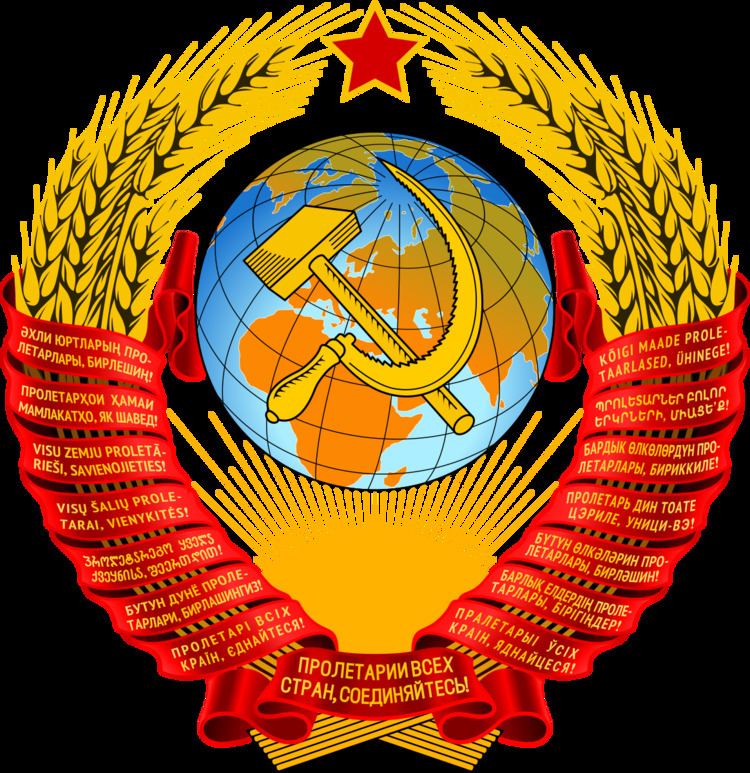Precursor None First holder Mikhail Kalinin Abolished 25 December 1991 | Formation 30 December 1922 Final holder Mikhail Gorbachev | |
 | ||
Residence Grand Kremlin Palace, Moscow | ||
The Constitution of the Soviet Union recognised the Presidium of the Supreme Soviet and the earlier Central Executive Committee (CEC) of the Congress of Soviets as the highest organs of state authority in the Union of Soviet Socialist Republics (USSR). Under the 1924, 1936 and 1977 Soviet Constitution these bodies served as the collective head of state of the Soviet Union. The Chairman of these bodies personally performed the largely ceremonial functions assigned to a single head of state but held little real power.
Contents
The Soviet Union was established in 1922. However, the country's first constitution was adopted in 1924. Before that time, the 1918 Constitution of the Russian Soviet Federative Socialist Republic was adopted as the constitution of the USSR. According to the 1918 Constitution, the All-Russian Central Executive Committee (CEC), whose chairman was head of state, had the power to determine what matters of income and taxation would go to the state budget and what would go to the local Soviets. The CEC could also limit taxes. In periods between convocations of the Congress of Soviets the CEC held supreme power. In between sessions of the Congress of Soviets the CEC was responsible for all the affairs of the Congress of Soviets. The CEC and the Congress of Soviets was replaced by the Presidium and the Supreme Soviet by several amendments to the 1936 constitution in 1938.
The Supreme Soviet was the highest organ of state power, and was the sole organ to hold legislative power in the Soviet Union. Sessions of the Supreme Soviet were convened by the Presidium twice a year; however, special sessions could be convened on the orders of a Union Republic. In the event of a disagreement between the Soviet of the Union and the Soviet of Nationalities the Presidium could form a conciliation commission. If this commission failed the Presidium could dissolve the Supreme Soviet and order new elections. The Chairman of the Presidium of the Supreme Soviet, along with the first and fifteen other vice chairmen, were, according to the 1977 Soviet Constitution, elected by the deputies of the Supreme Soviet. Just as with the CEC under Joseph Stalin's rule, the Chairman of the Presidium had very little power because supreme power was in the hands of the General Secretary of the Communist Party of the Soviet Union (CPSU).
The Presidency was established in 1990 and the President would, according to the altered constitution, be elected by the Soviet people by direct and secret ballot. However, the first and only Soviet President, Mikhail Gorbachev, was elected by the democratically elected Congress of People's Deputies. In connection with the dissolution of the Soviet Union national elections for the office of President never took place. To be elected to the office a person must have been a Soviet citizen and older than thirty-five but younger than sixty-five years. The same person could not be elected president for more than two terms. The Presidency was the highest state office, and was the most important office in the Soviet Union by influence and recognition, eclipsing that of Premier and General Secretary. With the establishment of the Presidency executive power was shared between the President and the Prime Minister. The Presidency was given broad powers, such as being responsible for negotiating the membership of the Cabinet of Ministers with the Supreme Soviet; the Prime Minister, however, was responsible for managing the nomenklatura and economic matters.
List of heads of state
Of the eleven individuals appointed head of state, three died in office of natural causes (Leonid Brezhnev, Yuri Andropov and Konstantin Chernenko), one held the position in a temporary role (Vasili Kuznetsov), and four held posts of party leader and head of state simultaneously (Brezhnev, Andropov, Chernenko and Mikhail Gorbachev). The first head of state was Mikhail Kalinin, who was inaugurated in 1922 after the Treaty on the Creation of the USSR. At over twenty years, Kalinin spent the longest time in office; he died shortly after his resignation in 1946. Andropov spent the shortest time in office.
List of vice heads of state
There have been four individuals appointed vice head of state. At over eight years, Vasily Kuznetsov spent the longest time in office. Gennady Yanayev spent the shortest time in office.
